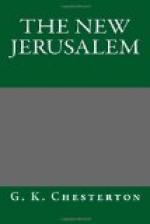that world every woman were a widow. When he
realised that these were not the masked mutes at a
very grisly funeral, but merely ladies literally obeying
a convention of wearing veils in public, he would
probably have a reaction of laughter. He would
be disposed to say flippantly that it must be, a dull
life, not only for the women but the men; and that
a man might well want five wives if he had to marry
them before he could even look at them. But he
will be wise not to be satisfied with such flippancy,
for the complete veiling of the Moslem women of Jerusalem,
though not a finer thing than the freedom of the Christian
woman of Bethlehem, is almost certainly a finer thing
than the more coquettish compromise of the other Moslem
women of Cairo. It simply means that the Moslem
religion is here more sincerely observed; and this
in turn is part of something that a sympathetic person
will soon feel in Jerusalem, if he has come from these
more commercial cities of the East; a spiritual tone
decidedly more delicate and dignified, like the clear
air about the mountain city. Whatever the human
vices involved, it is not altogether for nothing that
this is the holy town of three great religions.
When all is said, he will feel that there are some
tricks that could not be played, some trades that
could not be plied, some shops that could not be opened,
within a stone’s throw of the Sepulchre.
This indefinable seriousness has its own fantasies
of fanaticism or formalism; but if these are vices
they are not vulgarities. There is no stronger
example of this than the real Jews of Jerusalem, especially
those from the ghettoes of eastern Europe. They
can be immediately picked out by the peculiar wisps
of hair worn on each side of the face, like something
between curls and whiskers. Sometimes they look
strangely effeminate, like some rococo burlesque of
the ringlets of an Early Victorian woman. Sometimes
they look considerably more like the horns of a devil;
and one need not be an Anti-Semite to say that the
face is often made to match. But though they
may be ugly, or even horrible, they are not vulgar
like the Jews at Brighton; they trail behind them
too many primeval traditions and laborious loyalties,
along with their grand though often greasy robes of
bronze or purple velvet. They often wear on
their heads that odd turban of fur worn by the Rabbis
in the pictures of Rembrandt. And indeed that
great name is not irrelevant; for the whole truth
at the back of Zionism is in the difference between
the picture of a Jew by Rembrandt and a picture of
a Jew by Sargent. For Rembrandt the Rabbi was,
in a special and double sense, a distinguished figure.
He was something distinct from the world of the artist,
who drew a Rabbi as he would a Brahmin. But Sargent
had to treat his sitters as solid citizens of England
or America; and consequently his pictures are direct
provocations to a pogrom. But the light that
Rembrandt loved falls not irreverently on the strange
hairy haloes that can still be seen on the shaven heads
of the Jews of Jerusalem. And I should be sorry
for any pogrom that brought down any of their grey
wisps or whiskers in sorrow to the grave.




